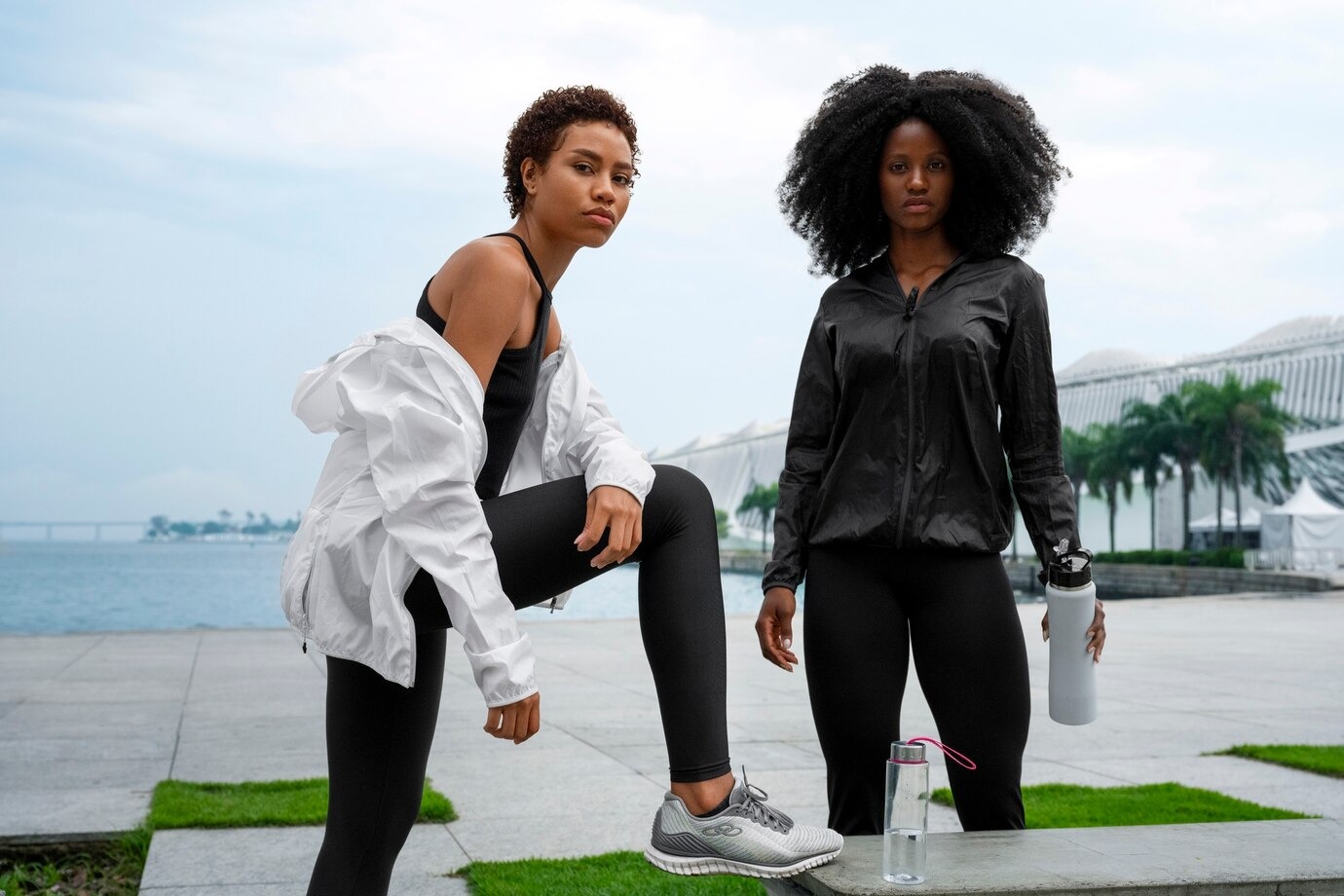
Fitness Meets Fashion – Wearable Gear That Looks Like Streetwear.
Wearable gear is transforming the way we approach both fitness and fashion, creating a seamless blend of style, technology, and performance. From smart leggings and temperature-regulating jackets to designer sneakers with embedded sensors, this trend allows individuals to stay active, express their personality, and move confidently through urban life, proving that functional athletic wear can also be street-ready and stylish.
💪 Fitness Guru
61 min read · 6, Oct 2025

Introduction: When Fitness Steps Onto the Runway
Once upon a time, gym clothes were just that—outfits designed for sweat, not style. But in today’s world, fitness and fashion are no longer separate realms. The evolution of wearable technology, coupled with the growing influence of athleisure and streetwear trends, has birthed a new hybrid: wearable gear that looks like fashion-forward streetwear but functions as performance apparel.
This transformation is not merely aesthetic. It’s a reflection of changing lifestyles—where health, comfort, and personal expression coexist seamlessly. Whether it’s yoga enthusiasts who wear sleek leggings to brunch or professionals who track their heart rate with a designer smartwatch, fitness fashion is now mainstream.
Let’s explore how technology, design innovation, and cultural shifts have merged fitness and fashion into a single stylish revolution.
The Rise of Athleisure and Streetwear Influence
The fusion of fitness and fashion began with athleisure, a term coined in the mid-2010s. Brands like Lululemon, Nike, and Adidas capitalized on the idea that workout wear could also be worn outside the gym. Soon, yoga pants, compression leggings, and breathable tops became everyday attire.
Streetwear, on the other hand, brought in the cool factor—hoodies, joggers, and sneakers that carried the swagger of skate parks and hip-hop culture. When these two worlds collided, the result was functional fashion—gear you could work out in, but also look great wearing at a café or on a city walk.
Today’s consumers demand versatility. They want clothes that fit their workout routines but also align with their urban, on-the-go lifestyles. This demand has pushed brands to reimagine materials, aesthetics, and technology integration.
Technology as a Fashion Statement
Modern fitness fashion isn’t just about looking good—it’s about being smart. The integration of wearable technology has completely changed how people approach fitness and personal style.
1. Smartwatches and Fitness Bands:
Apple, Fitbit, Garmin, and Samsung have turned fitness tracking into a style statement. Smartwatches are now designed with customizable faces, premium materials, and interchangeable straps, making them suitable for both workouts and boardrooms.
2. Smart Clothing:
Companies like Under Armour, Hexoskin, and Sensoria are developing smart shirts and leggings embedded with sensors that track heart rate, breathing, posture, and muscle activity. What’s exciting is that these garments don’t look like tech devices—they resemble sleek streetwear with minimalistic aesthetics.
3. Heated and Cooling Jackets:
Fashion brands like Ralph Lauren and Ministry of Supply have developed temperature-regulating outerwear using embedded sensors. These pieces look like stylish jackets but adapt to the wearer’s body temperature during a run or commute.
4. Sound and Light Integration:
Innovative gear like Bluetooth-enabled beanies or reflective LED jackets caters to both utility and fashion. They appeal especially to night runners and cyclists who need visibility but also want to stay stylish.
Technology has transformed clothing from a passive garment to an active partner in one’s health journey—without compromising on design.
Design Innovation: Where Fabric Meets Function
The secret behind fashionable fitness wear lies in material innovation.
1. Performance Fabrics:
Today’s fitness gear uses lightweight, breathable, sweat-wicking materials like spandex blends, recycled polyester, and bamboo fiber. These fabrics are designed for movement while maintaining a polished, street-ready look.
2. Seamless Construction:
Modern activewear embraces seamless knitting technology. This eliminates chafing and creates a sleek silhouette that transitions easily from gym to casual wear.
3. Minimalism Meets Edge:
Designers are focusing on neutral palettes—black, white, beige—with occasional neon highlights or futuristic metallics. The aesthetic mimics urban streetwear while retaining athletic functionality.
4. Sustainability as Style:
Eco-friendly fashion has become part of the trend. Brands like Girlfriend Collective and Patagonia make stylish performance wear from recycled bottles and sustainable fibers—appealing to both environmental and fashion-conscious consumers.
The result? A new genre of clothing that feels as good as it looks, both in motion and at rest.
Top Brands Merging Fitness and Fashion
Several trailblazing brands have mastered the art of blending streetwear style with fitness technology:
1. Nike Tech Pack – Combines athletic functionality with futuristic design aesthetics. The pieces are sleek, layered, and versatile enough for streetwear.
2. Lululemon Lab – The experimental arm of Lululemon creates limited-edition collections that mix urban tailoring with performance fabrics.
3. Adidas x Stella McCartney – A collaboration that redefined high-fashion sportswear, merging technical excellence with runway appeal.
4. Puma x Fenty by Rihanna – Pushed the boundaries of sporty streetwear with bold silhouettes and unapologetic flair.
5. Gymshark – Born as a fitness brand, it has evolved into a streetwear-inspired powerhouse with compression sets and oversized hoodies that dominate social media.
6. Athleta and Alo Yoga – Champions of athleisure, they make yoga-inspired apparel that can double as stylish street outfits.
7. Wearable Tech Collabs – Apple x Hermès smartwatches, or Samsung’s luxury watch straps, showcase how fashion and tech giants are collaborating to redefine wearable aesthetics.
These brands understand one core truth: people no longer dress for occasions, they dress for lifestyle—and that lifestyle includes fitness, comfort, and style.
Cultural Shifts Behind the Trend
The rise of wearable streetwear isn’t accidental—it reflects deeper cultural trends.
1. Wellness as a Lifestyle:
Post-pandemic, health and fitness have become integral to personal identity. People want to display wellness as part of who they are—clothing becomes a form of that expression.
2. Digital Influence:
Social media, especially Instagram, TikTok, and YouTube, has made “looking fit” as important as “being fit.” Influencers often sport athleisure brands as everyday wear, shaping consumer preferences globally.
3. Gender-Neutral Design:
The new fitness fashion movement often embraces unisex aesthetics—oversized fits, monochromatic tones, and minimalist designs appeal to all genders.
4. Work-Life Blur:
With remote work and flexible lifestyles, clothes that transition from home to workout to casual outing have become the norm. Versatile activewear fulfills this need.
5. Urban Identity:
Streetwear has always represented individuality and rebellion. By merging fitness gear with this aesthetic, consumers can express both discipline (fitness) and freedom (fashion).
The Future of Wearable Fitness Fashion
The next wave of wearable streetwear will be hyper-personalized and data-driven. Imagine clothing that adjusts tightness based on muscle fatigue or shoes that track running metrics while lighting up with dynamic colors synced to your playlist.
Trends to watch include:
- Smart textiles that collect biometric data.
- Augmented reality (AR) clothing that changes patterns through mobile apps.
- Modular fashion, where tech components can be attached or removed.
- 3D-printed activewear, offering perfect fits and sustainable production.
As technology advances, the distinction between a fitness tracker and a fashion accessory will completely disappear.
Challenges in the Fusion of Fitness and Fashion
While the fitness-fashion revolution is exciting, it also faces challenges:
- Cost: Smart and designer activewear often comes at a premium, limiting accessibility.
- Durability: Integrating electronics in clothing poses issues related to washing and long-term use.
- Privacy Concerns: Wearable tech that tracks biometrics raises data security questions.
- Sustainability: Tech-infused fashion risks adding to e-waste unless recyclable components are developed.
Brands addressing these concerns through innovation and ethical practices will shape the future of this growing sector.
The fusion of fitness and fashion has evolved into one of the most exciting and defining trends of the 21st century, where gym wear is no longer confined to the four walls of a fitness studio but has stepped boldly onto the streets, redefining comfort, style, and functionality in a single stroke. Today’s generation refuses to compartmentalize life into rigid boxes like “work,” “play,” or “workout.” Instead, they seek seamless transitions, and this lifestyle shift has given rise to wearable gear that not only enhances performance but also reflects individual identity and aesthetic preferences. This revolution, known as “wearable streetwear,” merges the power of high-performance fitness technology with the bold confidence of street fashion. In essence, it symbolizes the rise of a culture where fitness meets fashion, blending health consciousness with artistic expression. Gone are the days when sweatpants and sneakers were just for athletes; now they represent a lifestyle of motion, mindfulness, and modernity. At its core, this movement has been powered by the athleisure boom, which redefined clothing norms across the globe. Brands like Nike, Lululemon, Adidas, and Puma began designing apparel that could move effortlessly from the yoga mat to the coffee shop, from the gym floor to the city street. Streetwear, with its urban roots in skate culture and hip-hop aesthetics, added the element of cool rebellion to the mix—resulting in clothing that is as expressive as it is functional. Imagine sleek leggings made of sweat-wicking fabric, styled with oversized hoodies and tech-enhanced sneakers that track your gait while lighting up in rhythm with your steps; that’s the world we live in today. Wearable gear has become more than an outfit—it’s an experience, a statement of who we are and how we live.
The integration of technology has taken this evolution to a whole new level. Wearable tech is no longer limited to wristbands and heart monitors; it’s now woven directly into the fabric of our clothes. Smart shirts can track your breathing and heart rate; leggings equipped with motion sensors can correct your yoga posture in real-time; and heated jackets can automatically adjust temperature according to your body’s needs. Major innovators such as Under Armour, Sensoria, Hexoskin, and Ministry of Supply are leading the charge by embedding micro-sensors, flexible circuits, and AI-powered feedback systems into fashionable garments that look no different from designer streetwear. Meanwhile, Apple, Fitbit, Garmin, and Samsung have turned fitness tracking into a luxury statement through customizable smartwatches made with titanium, ceramic, and leather, often in collaboration with luxury brands like Hermès. These smart devices seamlessly blend into everyday fashion while quietly monitoring health metrics. Even outerwear has entered the tech revolution—self-heating coats, cooling vests, and reflective LED jackets are not just innovations in comfort and safety; they are redefining what fashion can do. This convergence of style and science represents a broader cultural shift where being healthy and looking stylish are no longer opposites but essential complements.
At the heart of wearable streetwear lies material innovation—the science of designing fabrics that can breathe, stretch, and adapt. Performance fabrics like recycled polyester, elastane blends, bamboo fiber, and smart textiles infused with silver ions (for odor control) ensure that these garments serve both function and fashion. Advanced knitting technologies create seamless, sculpted designs that flatter the body while eliminating chafing during workouts. Minimalist aesthetics—clean lines, neutral tones, and subtle futuristic accents—make such clothing perfect for gym sessions, work-from-home setups, or social outings. Additionally, the movement toward sustainability has redefined the design philosophy of fitness fashion. Companies such as Girlfriend Collective, Patagonia, and Adidas now use recycled ocean plastics, organic cotton, and ethically sourced dyes to create performance wear that’s not only stylish but environmentally responsible. Consumers, particularly Millennials and Gen Z, are driving this eco-conscious shift by demanding transparency and sustainability in their wardrobes. The result is a fashion category that’s not only intelligent and functional but also ethically aware.
The cultural underpinnings of this trend are equally fascinating. Wellness has evolved from a niche interest into a lifestyle and even a status symbol. People showcase their fitness routines, smartwatches, and activewear on social media platforms like Instagram and TikTok, making wellness both aspirational and fashionable. Fitness influencers have replaced traditional models in shaping trends, and their influence has normalized the idea of wearing gym clothes all day long. Moreover, the growing acceptance of gender-neutral designs—with oversized silhouettes, unisex colors, and universal fits—has made wearable streetwear inclusive and versatile. This androgynous edge echoes the broader push toward self-expression and individuality in modern fashion. The post-pandemic world further accelerated this shift as people began prioritizing comfort and health. With remote work blurring the boundaries between personal and professional life, clothes that can transition from a morning workout to a virtual meeting to an evening walk became essential. Wearable fitness fashion fulfills exactly that need—a wardrobe that adapts to your life’s rhythm rather than dictating it.
From a brand perspective, the list of innovators shaping this market is long and impressive. Nike Tech Pack combines athletic precision with futuristic street style, offering gear that looks like runway fashion but performs like sportswear. Lululemon Lab pushes experimentation by blending city tailoring with active fabrics, while Adidas x Stella McCartney brings luxury craftsmanship to functional apparel. Puma’s collaboration with Rihanna (Fenty) fused bold feminine energy with street-inspired athletic wear, and Gymshark has built an empire by merging fitness credibility with influencer-driven street appeal. Meanwhile, collaborations between fashion houses and tech giants—such as Apple x Hermès or Samsung x Maison Kitsuné—blur the lines between accessory and innovation. These partnerships reflect a single truth: people today dress for their lifestyle, not for specific occasions.
Looking ahead, the future of wearable streetwear is dazzlingly high-tech and hyper-personalized. Innovations in smart textiles will lead to self-adjusting fabrics that tighten to support muscles or relax to aid recovery. 3D printing will allow custom-fitted garments with zero waste, while augmented reality (AR) will make it possible to change the color or pattern of your outfit through a mobile app. AI-driven design systems will tailor clothing recommendations to your posture, climate, and mood, blurring the lines between customization and creativity. Shoes may soon have built-in sensors that map pressure points or even generate energy from motion. As all this unfolds, wearable streetwear will continue to symbolize the harmony of technology, sustainability, and self-expression.
However, this stylish revolution is not without challenges. High production costs keep smart garments out of reach for many consumers. Integrating electronics into washable, flexible fabrics remains a technological hurdle. Privacy concerns around biometric data collection are growing, as users question how their health information is stored and shared. And while sustainability is a key trend, electronic components risk contributing to e-waste unless brands develop recyclable solutions. Overcoming these issues will determine which companies truly lead the next era of wearable fashion.
In conclusion, the meeting point of fitness and fashion represents more than a trend—it’s a transformation in how we live, move, and express ourselves. The gym outfit is now an identity statement; the smartwatch is as much an accessory as a fitness tracker; the hoodie you wear to the café might be regulating your body temperature. The fusion of fitness and fashion through wearable streetwear has given rise to a new culture of conscious consumers who value both aesthetics and performance. It’s a movement driven by innovation, sustained by style, and destined to redefine the very meaning of modern apparel.
The intersection of fitness and fashion has grown into one of the most remarkable trends of contemporary lifestyle, where activewear is no longer limited to gyms or studios but has permeated urban streets, workplaces, cafes, and even social gatherings, reflecting a cultural shift in which personal health, aesthetics, and technology are seamlessly interwoven, and today’s consumers expect clothing that not only performs under rigorous physical activity but also conveys their identity, sense of style, and lifestyle choices without compromise; this transformation is largely driven by the explosive growth of athleisure, which redefined traditional clothing norms by making garments versatile enough to serve multiple purposes—leggings that wick sweat and stretch comfortably while also appearing sleek and fashionable, hoodies that combine lightweight, breathable fabrics with oversized, street-inspired silhouettes, and sneakers that incorporate advanced cushioning and motion-tracking technology while maintaining a trendy design suitable for city streets or casual outings; moreover, streetwear culture, originating from skateboarding, hip-hop, and urban youth movements, has injected a bold, expressive energy into the mix, encouraging individuals to view their activewear not merely as functional clothing but as a statement of personality, confidence, and even rebellion against conventional fashion rules, and when this influence merges with fitness-driven design, it creates an entirely new category of wearable streetwear that blurs the boundaries between technology, performance, and aesthetics, exemplified by garments such as smart leggings that monitor muscle activity, posture-correcting shirts embedded with sensors, jackets that regulate temperature or illuminate with LEDs for visibility during night runs, and shoes capable of tracking gait and performance metrics, all of which showcase how technology can be discreetly embedded into fashion without compromising style, and in fact, enhance it; leading brands have recognized this convergence and strategically responded, with Nike’s Tech Pack offering futuristic, layered designs that retain technical excellence, Lululemon Lab experimenting with city-inspired tailoring in performance fabrics, Adidas x Stella McCartney marrying luxury fashion sensibilities with activewear functionality, and Puma’s collaboration with Rihanna through Fenty bringing bold, unapologetic street-inspired aesthetics to sportswear, while fitness brands like Gymshark have leveraged social media and influencer culture to create a cult-like following for clothing that feels both aspirational and accessible, demonstrating that the success of wearable streetwear lies not only in its functionality but also in its ability to connect emotionally with consumers who increasingly seek self-expression alongside fitness, and this emotional resonance is further amplified by the integration of smart technology, which turns ordinary garments into interactive tools that provide real-time feedback on health and performance metrics, thereby offering practical benefits while simultaneously enhancing style; beyond aesthetics and technology, material innovation plays a critical role in shaping this evolution, with fabrics like recycled polyester, elastane blends, bamboo fiber, and silver-infused textiles offering moisture-wicking, odor-resistant, stretchable, and breathable properties that make clothing comfortable for prolonged wear while supporting athletic activity, and the development of seamless construction techniques eliminates friction and improves the visual flow of garments, resulting in pieces that are sculpted, sleek, and flattering for the body, which allows consumers to confidently wear them outside of workouts without feeling out of place, and the emphasis on sustainability further elevates the appeal, as modern consumers—especially Millennials and Gen Z—demand environmentally conscious production methods, prompting brands such as Girlfriend Collective, Patagonia, and Adidas to embrace recycled and organic materials, eco-friendly dyes, and circular manufacturing practices, which not only reduce environmental impact but also resonate with values-driven consumers seeking authenticity and responsibility in their fashion choices; this cultural shift is underpinned by broader societal trends, including the post-pandemic focus on wellness, the normalization of remote work, and the increasing integration of physical fitness into daily routines, which have collectively encouraged clothing that adapts seamlessly to multiple contexts—whether a morning workout, a work-from-home session, or a casual stroll through the city—and the rise of social media has accelerated these changes by showcasing fitness-focused lifestyles, athleisure, and streetwear aesthetics as aspirational norms, with influencers and fitness personalities acting as both trendsetters and cultural ambassadors, making it clear that looking fit and stylish has become intertwined with social identity, while gender-neutral and unisex designs contribute to inclusivity and versatility, embracing oversized silhouettes, monochromatic palettes, and minimalist designs that appeal across genders and body types, effectively democratizing wearable streetwear and making it accessible to a diverse audience; the future of this intersection promises even more innovation, with smart textiles that adjust tightness or temperature based on biometric feedback, augmented reality-enabled garments that allow dynamic pattern and color changes, AI-assisted clothing customization for personalized fit and style recommendations, and modular fashion systems where electronic components can be added or removed based on need, ensuring that the blend of fitness, technology, and fashion continues to evolve while meeting the practical, emotional, and aesthetic needs of consumers, and although challenges remain—such as high costs, durability of tech-integrated fabrics, privacy concerns regarding biometric data, and potential e-waste from electronic components—the ongoing advancements in design, sustainability, and technological integration suggest that wearable streetwear will continue to redefine what it means to dress for modern life, creating a world where fitness apparel is not only functional but aspirational, stylish, and deeply personal, ultimately reflecting a holistic lifestyle that prioritizes health, self-expression, and adaptability without compromise, and in this way, the union of fitness and fashion is less a passing trend than a long-term transformation in the way clothing functions, communicates identity, and interacts with technology, representing a paradigm in which individuals no longer need to choose between style and performance, because wearable streetwear successfully embodies both, offering garments that are intelligent, comfortable, visually compelling, sustainable, and socially relevant, and as this movement continues to grow, it will likely inspire further innovations across the fashion and fitness industries, encouraging designers, engineers, and consumers alike to envision clothing as a multidimensional experience that engages the body, mind, and sense of style simultaneously, establishing a new standard where the streets and the gym are no longer separate domains, but part of a continuous lifestyle landscape shaped by fashionable, functional, and technologically advanced activewear that caters to the evolving demands of modern, health-conscious, and style-oriented individuals around the world.
Conclusion
Fitness and fashion have finally found their perfect match. The new generation of wearable gear is not just about performance but also about personality. The gym look is no longer confined to the gym—it’s part of everyday identity.
This trend reflects a world where function meets flair, where people demand clothing that adapts to their pace and represents their values. Whether through smartwatches that match designer handbags or sneakers that analyze gait patterns, wearable streetwear is redefining how we experience health, style, and self-expression.
In essence, fitness meets fashion is not just a passing fad—it’s the uniform of a modern, mindful, mobile generation.
Q&A Section
Q1: What is wearable streetwear?
Ans: Wearable streetwear refers to clothing and accessories that combine the functionality of fitness gear (like moisture-wicking fabrics or fitness tracking tech) with the aesthetics of streetwear fashion, making them suitable for both workouts and casual outings.
Q2: How is technology influencing fitness fashion?
Ans: Technology is enabling smart fabrics, embedded sensors, and wearable devices that monitor fitness metrics while maintaining a stylish, everyday appearance. Examples include smart leggings, fitness-tracking jackets, and designer smartwatches.
Q3: Why is athleisure so popular?
Ans: Athleisure’s popularity stems from its comfort, versatility, and alignment with modern lifestyles that blur the lines between work, fitness, and leisure. It allows individuals to stay active without sacrificing style.
Q4: Are there sustainable options in wearable streetwear?
Ans: Yes. Many brands now use recycled fabrics, organic fibers, and eco-friendly dyes. Companies like Patagonia, Girlfriend Collective, and Adidas are pioneers in sustainable activewear.
Q5: What’s the future of wearable fitness fashion?
Ans: The future lies in intelligent textiles, AR-enabled designs, 3D printing, and modular clothing systems—garments that not only adapt to physical performance but also reflect personal style dynamically.
Similar Articles
Find more relatable content in similar Articles

Eco-Fitness: Training While Helping the Environment...
Eco-Fitness is a transformativ.. Read More

How Nutrition Impacts Hair and Nail Health..
Healthy hair and nails reflec.. Read More

Natural Hair Care Tips for Healthy Growth..
Natural hair care focuses on .. Read More

Fitness Meets Fashion – Wearable Gear That Looks Like Street..
Wearable gear is transforming .. Read More
© 2024 Copyrights by rFitness. All Rights Reserved.